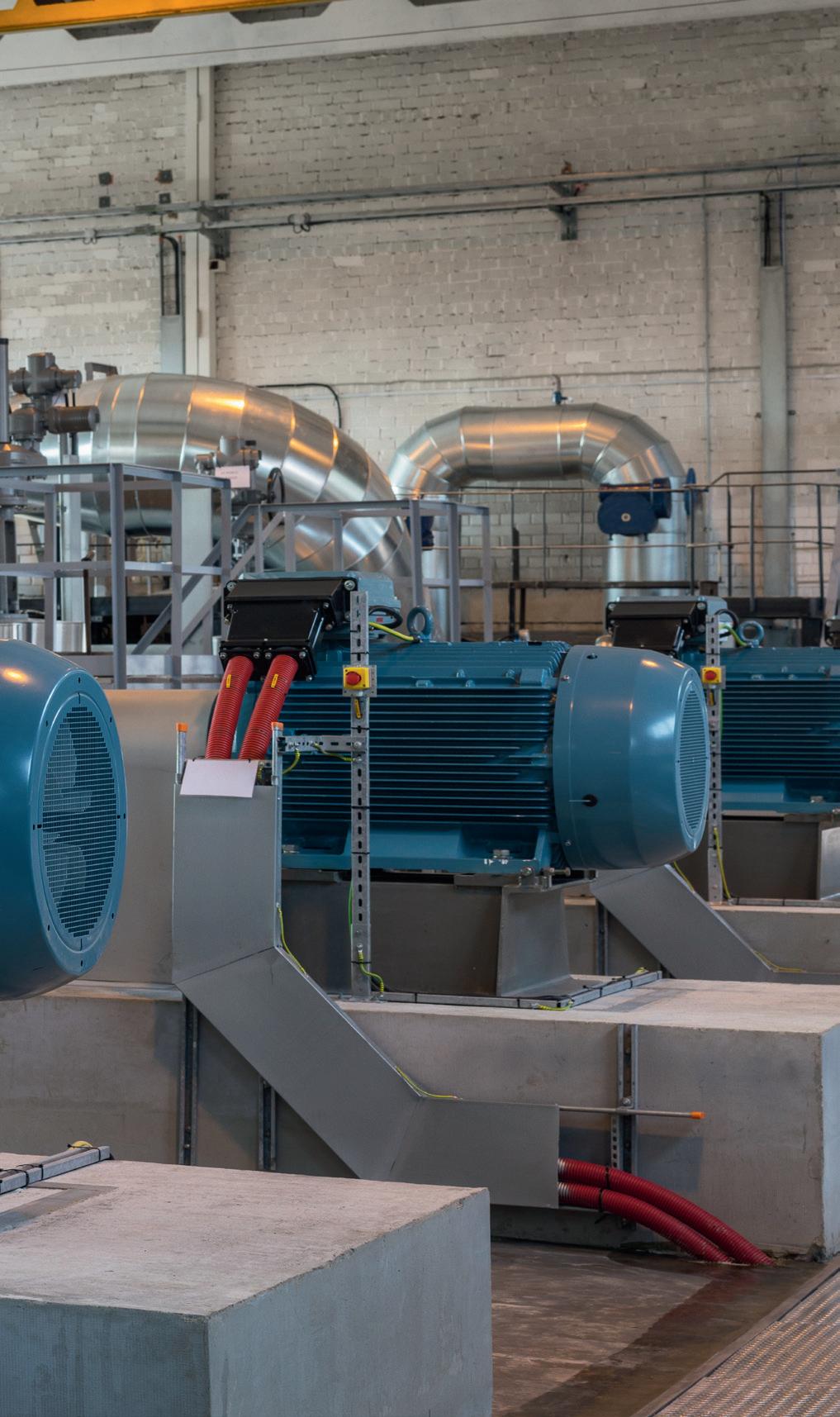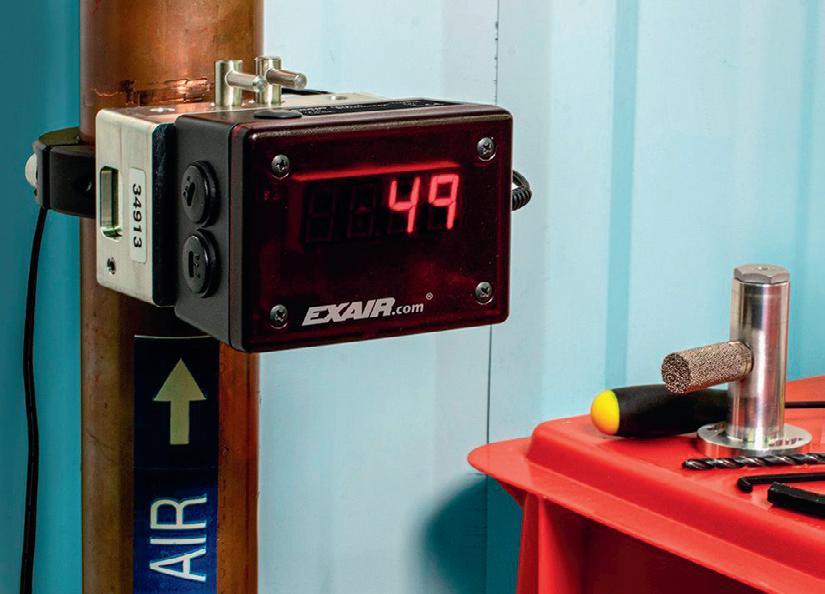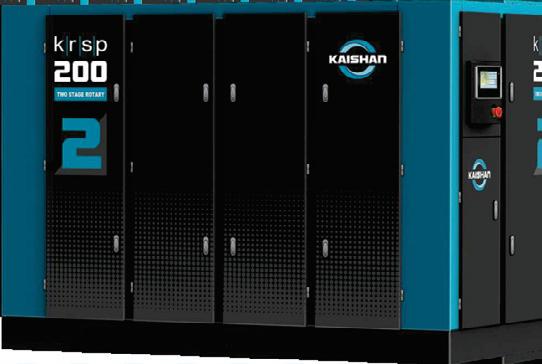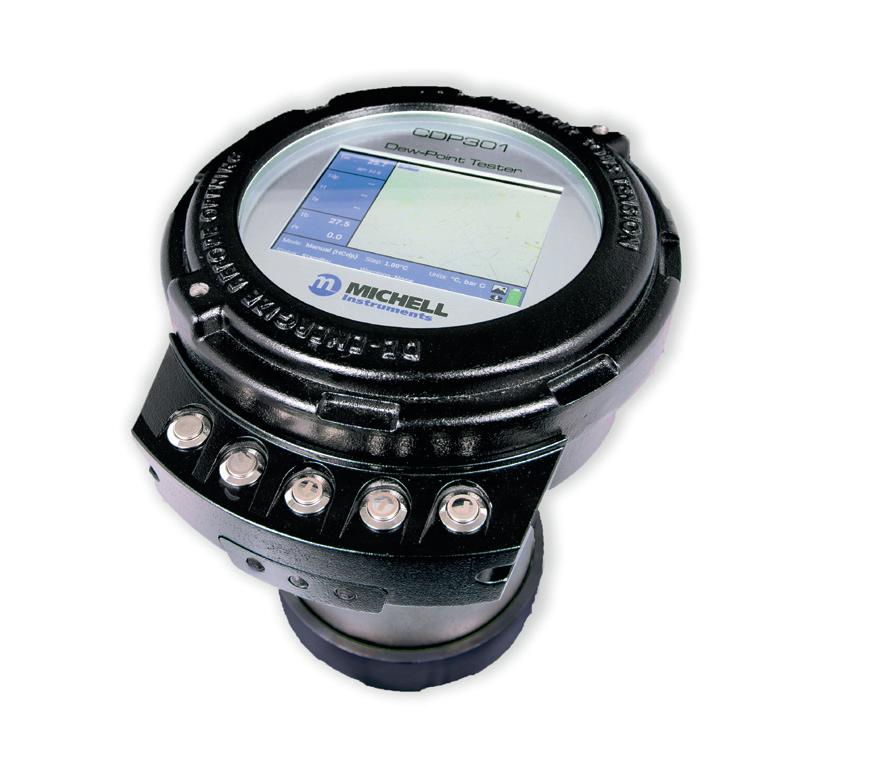
14 minute read
Digitalisation: it’s time to walk the walk
Tom Hardy, Automation Solutions Innovator, Yokogawa
When looking at areas for process improvement through digitalisation, rotating equipment stands out as having the greatest potential ROI.
the monitoring of
IIoT, Big Data, Industry 4.0 and many other terms have been discussed for almost 10 years, but with little in the way of actual outcomes. Extravagant vendor marketing has dazzled us with possibilities yet failed to provide anything tangible. What has happened is disillusionment among many end users who have been convinced to part with hard-fought budget based upon promises that have failed to materialise. Not only have traditional vendors been involved, but the rise of IoT and its potential as a new market has attracted many new vendors and consultants to the process industries, many with an understanding of industrial processes that is questionable.
Rotating machinery is the most widely used form of mechanical equipment in process industries yet can also be the most problematic. Operational faults can not only lead to machine and process downtime, but also excess energy consumption, loss of production, safety incidents and the potential for catastrophic damage. It’s clear that when reviewing areas for process improvement, rotating equipment stands out above many others: that is, if you know what to look for.
Research has shown that the majority of equipment damage in this area is caused during installation, start-up or shutdown. Other longer-term factors can slowly erode performance, such as bearing wear, part degradation, lubrication issues and rising imbalance. Degradation will reveal itself in many ways, the challenge being to identify the signs and take corrective action early. In doing so you are gifted the potential to improve reliability and performance, increase overall life expectancy and maximise return on investment from your machinery.
With degradation occurring very slowly and over long periods it can, as mentioned, be difficult to identify. Rotating machinery in a slow state of decline will show irregular or increased vibration, elevated surface temperature and an altered acoustic profile. In the early stages these indicators are very subtle and challenging to pick up using normal diagnostic methods. Yet the benefits in doing so are huge, allowing early stage corrective action in the most efficient and least disruptive manner.
Each application has its nuances, but in general there are a multitude of factors that can impact the performance and life of plant process equipment. • Environmental degradation: environmental conditions such as corrosive gas and dust, climate conditions such as desert and snow. • Thermal degradation: conduction and radiation from heat sources. • Mechanical deterioration: wear and tear. • Location: foundation degradation, movement, shock.
Understanding the process and its environment — and how they impact performance — is the first step in planning and optimising maintenance strategies. Research suggests that approximately 40% of expenditure on rotating machinery is wasted in ineffective maintenance. Conventional preventive techniques performed during operator rounds are time-intensive and not always possible to perform effectively, and as a result degradation is often detected too late to be useful.
© Stock.Adobe.com/au/imantsu

Utilising sensors designed for condition monitoring can provide precise readings at more frequent intervals and allow for more accurate decision-making without the maintenance overhead. Sensing vibration and surface temperature can equip operations personnel with the data required to make more informed decisions on an ongoing basis — that is if they are designed for the environment in which they are to operate, if location is carefully considered, they have the means to communicate effectively in confined environments, and there is a clear understanding of what you want to measure and why.
Let’s be clear that in pursuing such a strategy you will be opening up a huge well of data and it’s easy to become disillusioned and intimidated when faced with such volumes. Yet careful, early-stage understanding of how to deal with such a rich dataset along with expected outcomes can smooth the process.
Machine learning technology can perform advanced analytics and pattern recognition on sensor data, detecting anomalies faster than any human ever could, all while generating alerts and automated performance reports. In doing so the creation of large databases of asset health progressively improves the effectiveness of the software, thus building a broader understanding of how the components of your process impact overall performance. Creation of equipment profiles, comparing like-for-like performance of assets, guiding anomaly detection rapidly and with greater accuracy, all contributes to the protection of process integrity. This is where the real value lies and where many proposed solutions have fallen down in recent years.
You don’t need high-end process equipment or millisecond data points to measure effectively with this type of strategy. Samples should be taken at much greater intervals and over longer periods, so patience is a virtue. It’s all about the collective data profile and how the machine behaves compared to how it should behave.
Devices designed for this purpose need to be easy to install compared to fixed precision sensors, keeping overhead to a minimum. Ideally, they would require no wiring, utilise wireless technology and be battery powered. Easy-to-deploy and maintenance-free sensors not only gain favour with maintenance teams for these reasons alone, but do so for the resulting output.
Operations teams also understand how the same conditions that contribute to machine degradation also affect the control and monitoring equipment around them. The last thing they need is to add hardware that is not fit for purpose, so any sensors used need to be rugged and have the ability to withstand the same harsh exposure. Most end users understand that commercial products are not necessarily the best fit for harsh industrial applications. The trouble is that cheap ‘flick-and-stick’ sensors seem appealing from a cost perspective, only to later reveal significant consequential costs due to performance and longevity issues.
Beyond the sensors, selecting complementary technology for existing plant architecture is important. LoRaWAN is an example of an IoT communications protocol that won’t interfere with existing industrial wireless networks, has long-range transmission capability and reduces network hardware required to cover large plant areas.
With sensor and connectivity issues addressed you need to be mindful of where your data will be held and analysed. There’s a lot of conjecture around this topic, with many solutions being sold that are ‘all or nothing’: hugely complex cloud-based analytic solutions for full site monitoring from day one, when many operations personnel want to dip a toe in the water first before being teased into the ocean. Although this may be a long-term goal, you need the initial flexibility and reassurance that you can start small and scale up as and when desired.
In our experience, machine learning should have the option to be performed in a private cloud or on-premises if and where possible. This provides scalability with minimal worry about cost, security or sovereignty while keeping your data close and your industrial network secure. Local solutions also allow for easy integration with other control systems without the hassle of third-party APIs.
Outcomes matter, so consider all aspects of what you want to achieve with condition monitoring and keep compromise to a minimum. If it’s not fit for purpose, there is a lack of understanding of your needs or it’s an ‘all or nothing’ offering, then it just might not be for you.
Yokogawa created the Sushi Sensor range to address all the above, and more. The company has been walking the walk for over 30 years in Australia and New Zealand ensuring the right technology, application and outcomes to support manufacturing in the region.
LONG-RANGE DATA LOGGERS
Delta Ohm has recently released the LR35 series of long-range data loggers that feature a range of several kilometres and up to four years of battery life.
Indoor and outdoor (IP67) versions are available. Measurement parameters include temperature, relative humidity, CO 2 , PM DP and solar energy. An optional display (LCD) is available for both indoor and outdoor versions.
Transmission from the data logger can be collected and viewed in a variety of ways including cloud-based platforms (Delta Ohm and third party), public gateways and commercial gateways (connected through Wi-Fi, Ethernet and 4G) and ‘The Things Network’ — an open source, decentralised infrastructure for the IoT.
Applications include environmental monitoring, agricultural applications (soil moisture, rain and solar), food and pharmaceutical manufacturing, storage and transport, solar farms, solar power and sunshine conditions.

W&B Instruments Pty Ltd
www.wandbinstruments.com.au

SERVO DRIVE The Fatek Automation SD3 series servo drive is a high-performance AC servo system with advanced functions that supports various motor options including low, medium and high inertia servos from 50 W through to 2 kW.
The SD3 offers many motion control functionalities for a wide range of industry and machine applications. In addition, the SD3 series implements Modbus communication protocol as a standard, to connect with the Fatek FBs PLC and the Fatek P5/P2 series HMI.
Major applications include machine tools and processing machines for various industries including textile machines, X-Y table control, sealing machines, feeding machines, carving machines, lathes, highspeed winding machines, cut-to-length applications, textile equipment and a large variety of automation machinery.
The drives are programmed using Servo studio software that eases set-up, tuning, state monitoring and effective use of the SD3 servo amplifier. With its enhanced functionality, users can set up the damping filter from the intuitive interface, use an additional function ‘vibration noise frequency measurement (FFT)’ and even get a log of the amplifier alarm. In addition, smooth start-up of the machine is facilitated through an amplifier point table (that can be set up to 16 points), using the test run features.
Global Automation Asia-Pacific
www.globalautomation.com.au




DIGITAL FLOWMETER Measuring compressed air consumption is the first step towards identifying high compressed air use areas and compressed air leaks, and optimising air use.
The EXAIR Digital Flowmeter has a digital display that shows the exact amount of compressed air being used, making it easy to identify costly leaks or inefficient air products. Many companies install the digital flowmeter on each major leg of their air distribution system to constantly monitor and benchmark compressed air usage.
EXAIR Digital Flowmeters are available in four fundamental versions and can be used on Schedule 40 iron pipe, Type L copper pipe or aluminium pipe. The Standard version is designed to provide accuracy and an easy-to-read display of current compressed air consumption, daily consumption or cumulative consumption, while the Wireless version has a radio module within each meter that transmits data to an Ethernetconnected gateway. Using the ZigBee mesh network protocol, data can be passed from meter to meter to extend the distance over which the wireless system can operate.
The Hot Tap version allows for installation under pressure, eliminating the need to isolate and remove pressure from the pipe it is being installed into, reducing installation time while maintaining safety. The Pressure Sensing version monitors pressure as well as flow with a pressure sensor mounted between the two flow sensing probes.
EXAIR’s Digital Flowmeters are easy to install, sensitive at low flows and no calibration or setup is required. They are also CE and RoHS compliant.
Compressed Air Australia Pty Ltd
www.caasafety.com.au


I/O MODULES FOR PACs The ICP DAS I-9K (analog I/O) and I-97K (digital I/O) I/O modules allow for the combining of a variety of I/O functions within the WP-9000, XP-9000, LX-9000 and LP-9000 programmable automation controllers (PACs).
The I-9012 AIO is a high-performance analog input module that provides 16-bit resolution and a sampling rate of up to 200 kS/s per channel. It provide eight input channels, and the input range is programmable to ±5 or ±10 V. The trigger output and the trigger input pin cloud allow a multitude of I-9K modules to be simultaneously sampled. The module also provides 4 kV ESD protection and 2500 VRMS intramodule isolation.
The I-97K DIO modules are based on a parallel interface with high communication speed and provide programmable poweron value, safe value and retentive functions. All the I-97K DI modules provide 16 channels and a DI low pass filter function.
ICP Electronics Australia Pty Ltd
www.icp-australia.com.au



BURNER SAFETY CONTROLLER The PNOZ m B1 Burner from the PNOZmulti 2 safe small controller range from Pilz supports simultaneous monitoring and safe control of furnaces from Version 10.12 of the PNOZmulti Configurator software tool.
Manufacturers of burner and thermal plant and machinery have a large number of legal and normative requirements to consider: with the PNOZ m B1 Burner, not only can users now configure a variety of burner applications more easily, but they can also monitor plant-dependent safety functions at the same time.
The burner base unit is supported from Version 10.12 of the corresponding PNOZmulti Configurator software tool, which now provides a burner function block for configuration of the base unit PNOZ m B1 Burner. This software element is certified in accordance with the relevant European standards, including EN 298 and EN 50156.
The burner function block emulates the advanced functionality of an electronic automatic burner control system with flexible configuration. As a result it is able to manage the entire burner plant. Users save time when designing and engineering their furnace so that various burner types, such as master and slave burners, direct or indirect ignition, low or high temperature operation, can be controlled and monitored safely.
Pilz Australia Industrial Automation LP
www.pilz.com.au
RUGGED EMBEDDED COMPUTER The PIP40 Series rugged embedded computer from MPL is based in the latest Intel technology and is available in a compact aluminium housing with DIN rail or flange to fit a rugged MIL IP67 enclosure, a 19″ rack system or an open frame solution with a cooling plate.
The chassis design allows the PIP40 to operate in moderate to harsh environments and integrates standard I/O connectors for easy connection or lockable headers, depending on housing choice or needs. The series can be used for most high-quality x86 applications where a complete but still expandable solution is needed.
The housings offer sufficient space for 2.5″ SSD or other expansions like UPS or RAID, as well as two mPCIe and three m.2 slots to allow expansion. The internal expansion bus allows the integration of PCIe/104 or PCIe cards. The series meets the CE and FCC standards, allowing EN50155, IEC 60945 or MIL-STD-810 certifications to be met.

Backplane Systems Technology Pty Ltd
www.backplane.com.au
PORTABLE HCDP TESTER The Michell CDP301 portable HCDP tester uses the chilled-mirror principle for both hydrocarbon and water dew-point measurements and is designed to follow the requirements as described in ASTM D1142. Based on the visual manual method of observing the formation of condensate, the CDP301 uses a high-definition visual image to assist users and allows image capture and reliable logging of measurements for later review.
The device features automatic mirror cooling rate control according to ISO 6327 and ASTM D1142 test methods for natural-gas dew-point measurements, and is self-contained and rechargeable battery powered. It is also Ex d certified for IECEx ATEX Zone 1 IIB+H2 T3 and has a 100 barg operating pressure rating.
The CDP301 offers greater than 60°C measurement depression range (up to 100 barg pressure) and better than ±0.5°C accuracy.
AMS Instrumentation & Calibration Pty Ltd
www.ams-ic.com.au

MODBUS TRANSMITTER WITH DUAL UNIVERSAL INPUTS Moore Industries has announced the TMZ PC-programmable Modbus transmitter with dual universal input channels, which accepts most industry standard temperature, current or voltage signals. This dual universal input (2PRG) model allows users to increase measurement density while also reducing overall point costs by doubling the monitoring capability in a single unit. The digital Modbus output of the TMZ also reduces error that is inherent on analog 4–20 mA output transmitters due to their required D/A conversion. Users can quickly and easily configure each TMZ universal input for any thermocouple, RTD, potentiometer, ohms, millivolt, mA or voltage signal with the company’s PC program. Since measurements from both inputs are available on the Modbus output, the host system has the option of monitoring each point individually or combining their readings for backup/ failover, averaging or differential measurement strategies. Additionally, the TMZ’s input terminal temperature reading used for cold junction compensation on thermocouple inputs is also available on the Modbus output, which is convenient for determining ambient or internal cabinet temperatures. Up to 32 TMZs (without repeaters) can be multi-dropped onto a single low-cost communication link (such as a twisted wire pair), eliminating the need to run a dedicated wire for each signal.
The TMZ is also available in single input channel models. All TMZ models are 100% made in the USA and feature long-term stability (5 years), 20-bit input resolution, isolation and robust RFI/EMI protection.
Moore Industries Pacific Inc
www.miinet.com








